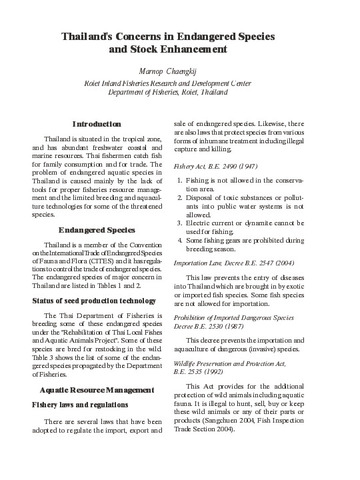Daytime habitat use and abundance of a freshwater shrimp Macrobrachium yui Holthuis, 1950 (Decapoda: Palaemonidae) in tropical forest stream, northern Laos
| dc.contributor.author | Kounthongbang, Aloun | |
| dc.contributor.author | Souliyamath, Pany | |
| dc.contributor.author | Chanthasone, Phonenaphet | |
| dc.contributor.author | Phommachan, Phutsamone | |
| dc.contributor.author | Lasasimma, Oulaytham | |
| dc.contributor.author | Okutsu, Tomoyuki | |
| dc.contributor.author | Ito, Sayaka | |
| dc.coverage.spatial | Xuang, Nam | en |
| dc.coverage.spatial | Laos | en |
| dc.date.accessioned | 2022-10-05T05:08:06Z | |
| dc.date.available | 2022-10-05T05:08:06Z | |
| dc.date.issued | 2021-11-30 | |
| dc.identifier.citation | Kounthongbang, A., Souliyamath, P., Chanthasone, P., Phommachan, P., Lasasimma, O., Okutsu, T., & Ito, S. (2021). Daytime habitat use and abundance of a freshwater shrimp Macrobrachium yui Holthuis, 1950 (Decapoda: Palaemonidae) in tropical forest stream, northern Laos. Crustacean Research, 50, 151–163. https://doi.org/10.18353/crustacea.50.0_151 | en |
| dc.identifier.issn | 0287-3478 | |
| dc.identifier.uri | http://hdl.handle.net/10862/6391 | |
| dc.description | Electronic supplementary material. | en |
| dc.description.abstract | From 2008 to 2014, we monitored the abundance and daytime habitat use of the freshwater shrimp Macrobrachium yui at a fixed site on a tributary of the Xuang River in northern Laos. Throughout the monitoring period, the shrimp M. yui showed strong preference for cobble and small boulder substrates, as well as moderate preferences for 21–30 cm depth and the midstream (251–350 cm distance from the bank) as daytime habitat factors. The shrimp M. yui, on the other hand, exhibited intense avoidance for shallower water depths (less than 10 cm), stagnant (0 cm s−1) and faster water velocity (greater than 60 cm s−1), finer substrates (from silt to gravel), and stream margin (less than 50 cm from the bank). During the day, the habitat with the cobble and small boulder in the midstream is probably the best place for the shrimp M. yui to hide from predators. The abundance of the shrimp M. yui had positive and negative correlations with water depth and sand percentage in the bottom sediment, respectively. It suggests that a decrease in water depth caused by increased deposition of fine sediment from the catchment has a negative impact on the shrimp abundance. | en |
| dc.description.sponsorship | This study was supported by the management expense grants from the Ministry of Agriculture, Forestry and Fisheries to the Japan International Research Center for Agricultural Sciences (JIRCAS) and by the research grant program of the Toyota Foundation (D12-R-0529). | en |
| dc.language.iso | en | en |
| dc.publisher | Carcinological Society of Japan | en |
| dc.relation.uri | https://www.jstage.jst.go.jp/article/crustacea/50/0/50_151/_pdf | en |
| dc.title | Daytime habitat use and abundance of a freshwater shrimp Macrobrachium yui Holthuis, 1950 (Decapoda: Palaemonidae) in tropical forest stream, northern Laos | en |
| dc.type | Article | en |
| dc.identifier.doi | 10.18353/crustacea.50.0_151 | |
| dc.citation.volume | 50 | |
| dc.citation.spage | 151 | |
| dc.citation.epage | 163 | |
| dc.citation.journalTitle | Crustacean Research | en |
| dc.subject.asfa | freshwater crustaceans | en |
| dc.subject.asfa | shrimp fisheries | en |
| dc.subject.asfa | habitats | en |
| dc.subject.asfa | habitat selection | en |
| dc.subject.asfa | juveniles | en |
| dc.subject.asfa | life cycle | en |
| dc.subject.asfa | sedimentation | en |
| dc.identifier.essn | 2189-5317 | |
| dc.subject.scientificName | Macrobrachium yui | en |
| local.subject | freshwater prawn | en |
| local.subject | life history | en |
| local.subject | habitat preference | en |
| local.subject | predation risk | en |
| local.subject | sediment deposition | en |
| local.subject | migration | en |
Files in this item
| Files | Size | Format | View |
|---|---|---|---|
|
There are no files associated with this item. |
|||
This item appears in the following Collection(s)
-
Journal Articles [1229]
These papers were contributed by Department staff to various national and international journals.




